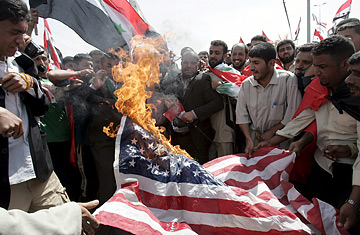
Supporters of Shi'ite cleric Moqtada al-Sadr burn a U.S. flag during a demonstration marking the fourth anniversary of the fall of Baghdad and the US-led occupation of Iraq, Najaf, April 9, 2007.
Diwaniyah, a town roughly 80 miles away from Baghdad, may be the wave of the near future if Sadr decides to flex his muscle. With more U.S. troops being sent to Baghdad, fighters from Sadr's Mahdi Army began appearing in force in Diwaniyah, a predominantly Shi'ite area of about 400,000 people sitting amid some of Iraq's most fertile farmlands. Violence soon followed. Women accused of violating the draconian brand of Islamic law espoused by al-Sadr and his Mahdi Army militia began turning up dead in Diwaniyah. Residents working with coalition forces at a Polish army base in the area became targets too, as did local journalists, wealthy residents and some members of the police, which are thought to have links to a rival Shi'ite militia, the Badr Brigade. By the end of March local officials say nearly 60 people had been killed. On March 20 Mahdi Army fighters torched police checkpoints in 15 different neighborhoods around Diwaniyah and laid claim to the territory, prompting U.S. forces to launch a counterattack on on April 6 and 7.
The fighting in Diwaniyah and the strident call to arms by Sadr on the fourth anniversary of the fall of Baghdad appear to signal the end of an uneasy truce between U.S. forces and the Mahdi army that emerged at the beginning of the U.S. troop surge into Baghdad. For a time it seemed that Sadr, who ordered his militia to stand down in Baghdad as the U.S. upped its presence, would indeed cooperate with the U.S. effort. U.S. commanders rightly claimed that the body count in Baghdad has dropped. But Sadr's patience with U.S. forces seems to have come to an end. And if the Mahdi Army indeed abandons its restraint in response to Sadr's public statements, then the Americans will have lost the one success the surge strategy has so far brought.
Proof of Sadr's ability to put legions on the move could be seen in Baghdad Sunday, as hundreds of people filled buses journeying to Najaf, the Shi'ite holy city 100 miles to the south, where Sadr's defiant statement was read. Today demonstrators draped in Iraqi flags marched for hours in Najaf and neighboring Kufa, denouncing the American presence in Iraq.
Baghdad itself was largely quiet for much of the day as 24-hour ban on vehicles brought a pause in the daily drumming of car bombs around the city. But by mid afternoon the sounds of violence in central Baghdad were back. Two huge explosions shook the central portion of the city, and the wail of sirens came soon after. If the short-lived truce is effectively dead, many more such sounds of violence are likely to fill the few quiet quarters of Baghdad in the days and weeks ahead.
